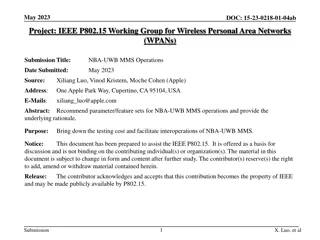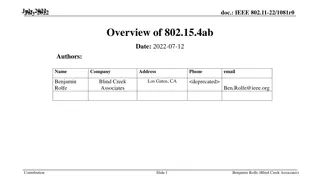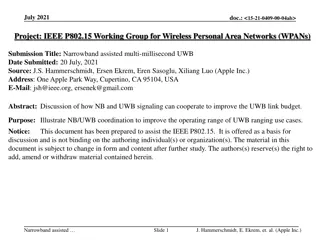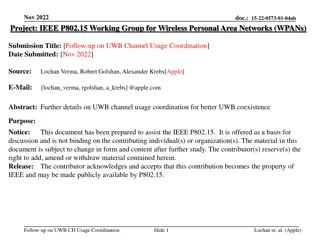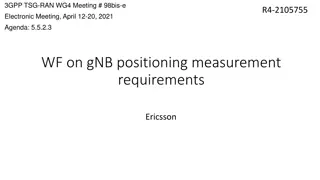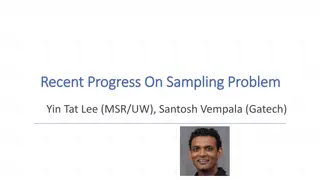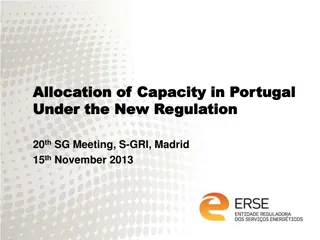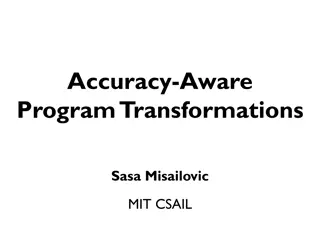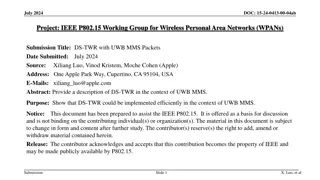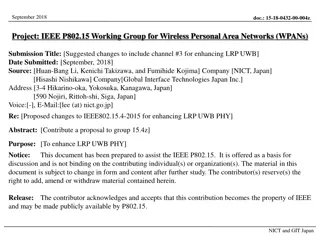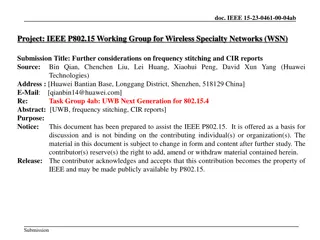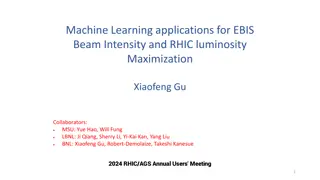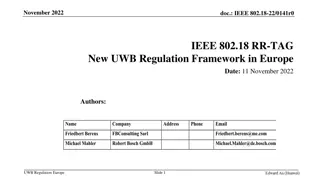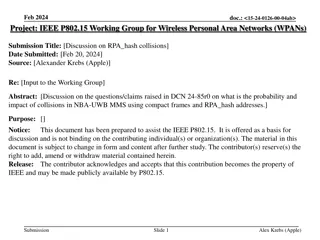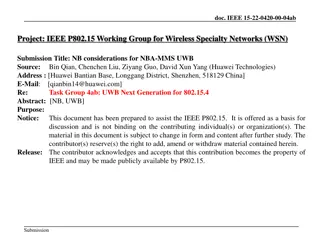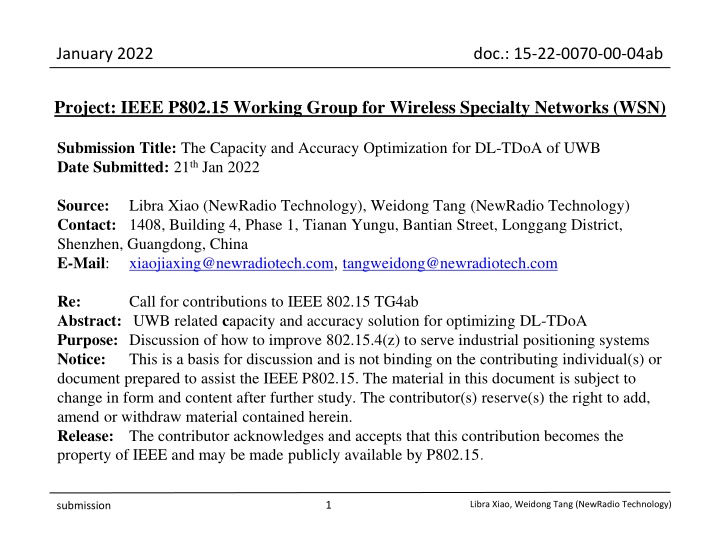
Optimizing UWB DL-TDoA for Industrial Positioning Systems
This submission, presented to the IEEE P802.15 Working Group, discusses enhancing the capacity and accuracy for Downlink Time Difference of Arrival (DL-TDoA) in Ultra-Wideband (UWB) technology to serve industrial positioning systems. The proposal aims to improve the IEEE 802.15.4 standard to support industrial use cases, focusing on interference mitigation, coexistence improvements, enhanced accuracy, and backward compatibility with Enhanced Ranging Capable Devices (ERDEVs). Various techniques including FDMA, CDMA, SDMA schemes, and hybrid operations are suggested to optimize UWB performance for higher throughput, reduced complexity, and improved reliability.
Download Presentation

Please find below an Image/Link to download the presentation.
The content on the website is provided AS IS for your information and personal use only. It may not be sold, licensed, or shared on other websites without obtaining consent from the author. If you encounter any issues during the download, it is possible that the publisher has removed the file from their server.
You are allowed to download the files provided on this website for personal or commercial use, subject to the condition that they are used lawfully. All files are the property of their respective owners.
The content on the website is provided AS IS for your information and personal use only. It may not be sold, licensed, or shared on other websites without obtaining consent from the author.
E N D
Presentation Transcript
January 2022 doc.: 15-22-0070-00-04ab Project: IEEE P802.15 Working Group for Wireless Specialty Networks (WSN) Submission Title: The Capacity and Accuracy Optimization for DL-TDoA of UWB Date Submitted: 21thJan 2022 Source: Contact: 1408, Building 4, Phase 1, Tianan Yungu, Bantian Street, Longgang District, Shenzhen, Guangdong, China E-Mail: xiaojiaxing@newradiotech.com, tangweidong@newradiotech.com Libra Xiao (NewRadio Technology), Weidong Tang (NewRadio Technology) Re: Abstract: UWB related capacity and accuracy solution for optimizing DL-TDoA Purpose: Discussion of how to improve 802.15.4(z) to serve industrial positioning systems Notice: This is a basis for discussion and is not binding on the contributing individual(s) or document prepared to assist the IEEE P802.15. The material in this document is subject to change in form and content after further study. The contributor(s) reserve(s) the right to add, amend or withdraw material contained herein. Release: The contributor acknowledges and accepts that this contribution becomes the property of IEEE and may be made publicly available by P802.15. Call for contributions to IEEE 802.15 TG4ab 1 Libra Xiao, Weidong Tang (NewRadio Technology) submission
January 2022 doc.: 15-22-0070-00-04ab PAR Objective The Proposed Solution (how addressed) Safeguards so that the high throughput data will not cause significant disruption to low duty-cycle ranging use cases Interference mitigation techniques to support higher density and higher Using FDMA/CDMA/SDMA schemes to improve traffic use cases capacity by reducing the interference among many UWB devices with higher density Other coexistence improvements Backward compatibility with enhanced ranging capable devices (ERDEVs) Improved link budget and/or reduced air-time Additional channels and operating frequencies Improvements to accuracy / precision / reliability and interoperability for Using channel pool, code pool or antenna pool to high-integrity ranging improve position accuracy / precision with the DL- TDoA algorithmagainst the TDMA scheme Reduced complexity and power consumption Hybrid operation with narrowband signaling to assist UWB Enhanced native discovery and connection setup mechanisms Sensing capabilities to support presence detection and environment mapping Low-power low-latency streaming Higher data-rate streaming allowing at least 50 Mbit/s of throughput Support for peer-to-peer, peer-to-multi-peer, and station-to- infrastructure protocols Infrastructure synchronization mechanisms 2 Libra Xiao, Weidong Tang (NewRadio Technology) submission
January 2022 doc.: 15-22-0070-00-04ab Previous submissions Reverse TDOA Applications and Technical Characteristics <15-21-0223-00-04ab>, April 2021, Zhenzhen Ye (Red Point Positioning) Downlink TDOA (DL-TDOA) Location Service in 802.15 <15-21-0488-00-04ab>, Sept 2021, Zhenzhen Ye (Red Point Positioning) DL-TDOA positioning TDMA scheme <15-21-0530-00-04ab>, Oct 2021, Jean-Marie Andr (ST microelectronics), Sven Zeisberg (Zigpos) Beacon and Ranging Frames to Support Downlink TDOA (DL-TDOA) Location Service in 802.15 <15-21-0616-00-04ab>, Nov 2021, Yongsen Ma and Zhenzhen Ye (Red Point Positioning) 3 Libra Xiao, Weidong Tang (NewRadio Technology) submission
January 2022 doc.: 15-22-0070-00-04ab Terminology UWB Anchor: the FFD in page 57 of IEEE 802.15.4-2020 operated as a coordinator UWB Tag: the FFD in page 57 of IEEE 802.15.4-2020 operated as a device Channel pool: communication channels approved in a region Code pool: a set of codes defined for the CDMA scheme. Antenna pool: a set of antennae used in the SDMA scheme 4 Libra Xiao, Weidong Tang (NewRadio Technology) submission
January 2022 doc.: 15-22-0070-00-04ab Recap of DL-TDoA Full Blown UWB anchors are regular anchors. They are connected to the mains and can communicate as much as needed. Battery Powered UWB anchors are not connected to the mains. They are easy for installation and useful for densifying a place where accurate DL-TDoA is needed. For such devices, the operation time must be minimized in order to save power and maximize the lifetime of battery. 5 Libra Xiao, Weidong Tang (NewRadio Technology) submission
January 2022 doc.: 15-22-0070-00-04ab The Problems of DL-TDoA with TDMA Extra Scheduling Complicate scheduling makes deployment more difficult and reduces capacity. Inaccurate Positioning A moving UWB tag can not achieve accurate ranging result, because it receives messages at different locations. 6 Libra Xiao, Weidong Tang (NewRadio Technology) submission
January 2022 doc.: 15-22-0070-00-04ab Positioning of a moving tag UWB Anchor A UWB Anchor B UWB Anchor B UWB Anchor A T 2 T1 Moving UWB Tag Moving UWB Tag UWB Anchor B UWB Anchor A Ra Rb UWB Anchor C UWB Anchor D UWB Anchor D UWB Anchor C Figure2. T2 Figure1.T1 UWB Anchor B UWB Anchor A UWB Anchor A UWB Anchor B Rd Rc UWB Anchor C UWB Anchor D Moving UWB Tag Moving UWB Tag T 4 T 3 UWB Anchor C UWB Anchor D UWB Anchor C UWB Anchor D Figure3. T3 Figure4. T4 Note: stand for the locations of the UWB tag during ranging 7 Libra Xiao, Weidong Tang (NewRadio Technology) submission
January 2022 doc.: 15-22-0070-00-04ab FDMA Solution Inaccuracy caused by moving can be addressed by FDMA scheme, CDMA (Code Division Multiple Access) scheme, or SDMA (Space Division Multiple Access) scheme. FDMA scheme Different UWB anchors operate at different frequencies. No scheduling is required during ranging. 8 Libra Xiao, Weidong Tang (NewRadio Technology) submission
January 2022 doc.: 15-22-0070-00-04ab An example of FDMA UWB Anchor B CH9 CH8 CH9 A Room CH6 CH5 UWB Tag CH8 CH9 CH8 UWB Channel CH5 CH6 CH9 CH8 CH9 CH6 CH5 CH9 CH8 CH8 Note This example uses the channel pool of CH5/CH6/CH8/CH9 in IEEE 802.15.4-2020 as showed in the figure above 9 Libra Xiao, Weidong Tang (NewRadio Technology) submission
January 2022 doc.: 15-22-0070-00-04ab CDMA and SDMA Solutions CDMA Full available spectrum Each UWB anchor with a unique code Low power spectrum density SDMA All devices operate at the same time and use the same space. A single UWB anchor can communicate with more UWB tags with the same frequency. Because directional spot-beam antennae are used, the UWB anchors in SDMA can track a moving UWB tag. 10 Libra Xiao, Weidong Tang (NewRadio Technology) submission
January 2022 doc.: 15-22-0070-00-04ab Advantages of Proposed Solutions FDMA: mature technology, simple equipment, no need for network synchronization, reliable work, high-capacity lines, high-efficiency, suitable for occasions with few stations and large capacity CDMA: no frequency planning, good confidentiality, strong anti-jamming and anti-interception capabilities, using multi-path characteristics and using RAKE technology to improve performance Cons: low spectrum utilization rate, not suitable for large-capacity systems SDMA: the same space using multiple beams 11 Libra Xiao, Weidong Tang (NewRadio Technology) submission
January 2022 doc.: 15-22-0070-00-04ab Summary of Proposed Schemes FDMA uses four or more channels at the same time. CDMA uses one channel, and four or more spread codes to differentiate UWB anchors. SDMA uses directional information to tell the difference between UWB anchors. 12 Libra Xiao, Weidong Tang (NewRadio Technology) submission
January 2022 doc.: 15-22-0070-00-04ab Proposed changes for MAC & PHY MAC: to support channel, code or antenna pools as option in specifications PHY: to support multiple channels , codes or antennae to work at the same time. 13 Libra Xiao, Weidong Tang (NewRadio Technology) submission
January 2022 doc.: 15-22-0070-00-04ab Thank you for listening! 14 Libra Xiao, Weidong Tang (NewRadio Technology) submission
January 2022 doc.: 15-22-0070-00-04ab Channels in IEEE 802.15.4-2020 15 Libra Xiao, Weidong Tang (NewRadio Technology) submission

